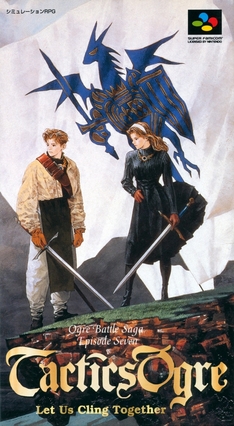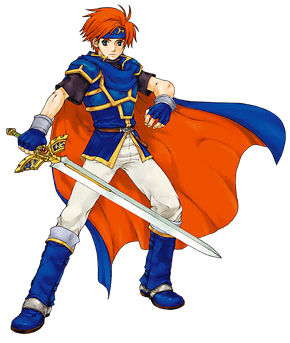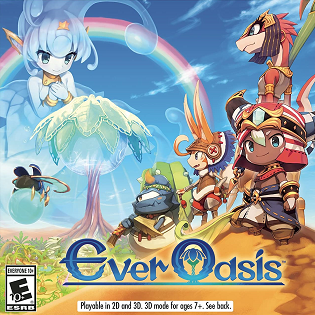
Final Fantasy Tactics is a 1997 tactical role-playing game developed and published by Square for the PlayStation. It was released in Japan in June 1997 and in North America in January 1998 by Sony Computer Entertainment, it is the first game of the Tactics sub-series within the Final Fantasy franchise, and the first entry set in the fictional world later known as Ivalice. The story follows Ramza Beoulve, a highborn cadet placed in the middle of a military conflict known as The Lion War, where two opposing noble factions are coveting the throne of the kingdom.

EarthBound, released in Japan as Mother 2: Gīgu no Gyakushū, is a 1994 role-playing video game developed by Ape Inc. and HAL Laboratory and published by Nintendo for the Super Nintendo Entertainment System as the second entry in the Mother series. The game focuses on Ness and his party of Paula, Jeff and Poo, as they travel the world to collect melodies from eight Sanctuaries in order to defeat the universal cosmic destroyer Giygas.
Yasumi Matsuno is a Japanese video game designer and writer. Matsuno was first introduced to video games in arcades while waiting for the train, and first played Space Invaders and Xevious there. He attended Hosei University for foreign policy but dropped out, and after working for a time as an economic reporter, he joined Quest Corporation.

Tactics Ogre: Let Us Cling Together is a 1995 tactical role-playing game developed and published by Quest Corporation for the Super Famicom. It was later ported to the Sega Saturn (1996) and the PlayStation (1997), the latter released in North America in 1998 by Atlus USA. The second entry in the Ogre Battle series, the story takes place in the war-torn kingdom of Valeria, where protagonist Denim Powell works in a local resistance force against occupying powers, ending up caught in the ethnic conflicts driving the war. Battles are turn-based, taking place on grid-based maps from an overhead perspective with a focus on positioning and using character class abilities.

Roy is a fictional character from Nintendo and Intelligent Systems' Fire Emblem video game series, who first appeared in the 2001 crossover fighting game Super Smash Bros. Melee as a representative character from the Fire Emblem series, along with Marth. He is the lead character of Fire Emblem: The Binding Blade; within the story, he is the son of Eliwood and heir presumptive of Pherae, who eventually becomes a major military leader.

Ogre Battle: The March of the Black Queen is a 1993 real-time tactical role-playing game developed by Quest Corporation. Originally published for Super NES by Quest in Japan and by Enix America in North America. It is the first installment of the Ogre Battle series. It was directed by Yasumi Matsuno, and designed by Matsuno with Akihiko Yoshida. The story of Ogre Battle focuses on a band of rebels as they lead a revolution against a corrupt reigning Empire, ruled by an evil Empress.

Level-5 Inc. is a Japanese video game developer and publisher based in Fukuoka. The company was founded in October 1998 by Akihiro Hino after he departed from Riverhillsoft. Early in its history, the company enjoyed a close relationship with Sony Computer Entertainment, with many of its games then funded by and produced in conjunction with them. Level-5 began self-publishing its games in Japan by the late 2000s, with other companies such as Nintendo handling publishing worldwide. The company is known for their Dark Cloud, Professor Layton, Inazuma Eleven, Ni no Kuni, Yo-kai Watch, and Snack World franchises.

ASH: Archaic Sealed Heat is a 2007 tactical role-playing game developed by Mistwalker and Racjin and published by Nintendo for the Nintendo DS exclusively in Japan. The storyline follows Aisya, princess of Millinear, after a fire monster burns the kingdom to ashes on her coronation day. She gains the ability to revive the dead as ash-formed bodies and sets out to investigate the cause behind the disaster. The gameplay combines tactical grid-based movement of 2D characters in the field with traditional turn-based battles, in which party members are represented by CGI models.
The music of the video game Final Fantasy XII was composed primarily by Hitoshi Sakimoto. Additional music was provided by Masaharu Iwata and Hayato Matsuo, who also orchestrated the opening and ending themes. Former regular series composer Nobuo Uematsu's only work for this game was "Kiss Me Good-Bye", the theme song sung by Angela Aki. The Final Fantasy XII Original Soundtrack was released on four Compact Discs in 2006 by Aniplex. A sampling of tracks from the soundtrack was released as an album entitled Selections from Final Fantasy XII Original Soundtrack, and was released in 2006 by Tofu Records. Additionally, a promotional digital album titled The Best of Final Fantasy XII was released on the Japanese localization of iTunes for download only in 2006. "Kiss Me Good-Bye" was released by Epic Records as a single in 2006, and Symphonic Poem "Hope", the complete music from the game's end credits, was released by Hats Unlimited the same year. An abridged version of the latter piece, which originally accompanied a promotional video for the game, was included in the official soundtrack album. An album of piano arrangements, titled Piano Collections Final Fantasy XII, was released by Square Enix in 2012.

Xenoblade Chronicles is an action role-playing game developed by Monolith Soft and published by Nintendo for the Wii. Initially released in Japan in 2010, it was later released in the PAL regions in 2011 and in North America in 2012. A port for the New Nintendo 3DS was released in 2015, and a remaster for the Nintendo Switch, titled Xenoblade Chronicles: Definitive Edition, was released in May 2020. Xenoblade Chronicles is the first entry in the Xenoblade Chronicles series, a subseries which forms part of the larger Xeno metaseries. Although it lacks direct narrative connections to previous Xeno games, like them, it incorporates aesthetic and narrative elements from both fantasy and science fiction. The game features navigation through an open world split into zones, side-quests tied to party members' affinity, and a real-time action-based battle system which incorporates Shulk's ability to see brief glimpses of the future.
The Guild series is a compilation of video games produced by Level-5 for the Nintendo 3DS in cooperation with various game designers. The first compilation, Guild01, consists of four games and was released at retail in Japan on May 31, 2012. Three of the titles have been announced for individual release on the Nintendo eShop in Western territories during Fall 2012. All four of them were released individually on the Japanese eShop not long after. A second compilation, Guild02, which features three games designed by Keiji Inafune, Kazuya Asano, Takemaru Abiko and Kaz Ayabe, was released on the Nintendo eShop in Japan during March 2013 and began releasing in Western territories in May 2013.

Tactics Ogre: Let Us Cling Together is a 2010 tactical role-playing game developed and published by Japanese company Square Enix. It is a remake of the 1995 Super Famicom title of the same name, second entry in the Ogre Battle series. The remake retains the same strategy RPG gameplay of the original, focusing on turn-based tactical battles and the use of character classes. The game incorporates additional features such as equipment crafting and the ability to revisit branch points in the game's narrative, in addition to multiplayer functionality. The storyline, following the actions of rebel fighter Denam Pavel during a civil war within the kingdom of Valeria, was also expanded with new scenes and characters.

Gamer Network Limited is a British digital media company based in London. Founded in 1999 by Rupert and Nick Loman, it owns brands—primarily editorial websites—relating to video game journalism and other video game businesses. Its flagship website, Eurogamer, was launched alongside the company. It began hosting the video game trade show EGX in 2008. ReedPop acquired Gamer Network in 2018 and sold it to IGN Entertainment in 2024.

Severed is an action-adventure video game developed and published by DrinkBox Studios for the PlayStation Vita, iOS, Wii U, Nintendo 3DS and Nintendo Switch. It was released on April 26, 2016, in North America and Europe for the PlayStation Vita and it was released on Wii U and iOS on September 22, 2016. It was released on Nintendo 3DS in Europe on September 22, 2016, North America on October 13, 2016. It was released in Japan on December 28, 2016.

Dragon Quest XI: Echoes of an Elusive Age is a 2017 role-playing video game by Square Enix. The eleventh entry in the long-running Dragon Quest video game series, it was released in Japan for the Nintendo 3DS and PlayStation 4 in July 2017 and worldwide for the PlayStation 4 and Windows in September 2018. An enhanced version, Dragon Quest XI S: Echoes of an Elusive Age – Definitive Edition, was released for the Nintendo Switch in September 2019; for PlayStation 4, Windows, and Xbox One in December 2020; and for Stadia in March 2021. Taking place in a world called Erdrea, the game follows the hero's quest to save the world from an impending darkness. Throughout the game, he explores challenges related to his prophesied Luminary identity as he endures persecution from those who demonize him.

Ever Oasis is an action-adventure role-playing video game developed by Grezzo and published by Nintendo for the Nintendo 3DS handheld game console. Revealed at E3 2016, the game was released in North America, Europe, and Australia in June 2017 and in Japan the following month. It was directed and produced by Koichi Ishii, the creator of the Chocobo and Moogle as well as the Mana series at Square Enix.

Miitopia is a 2016 role-playing video game by Nintendo originally released for the Nintendo 3DS in Japan in 2016 and worldwide in 2017, with a remastered version released for the Nintendo Switch in May 21, 2021. The game features customizable Mii characters in a turn-based battle system and follows the story of a group of heroes battling the Dark Lord, who is stealing the faces of Miitopia's inhabitants. The game received mixed reviews, with critics praising its creative life simulation elements and humor while criticizing its combat system and repetitiveness.
Paper Mario is a video game series and part of the Mario franchise, developed by Intelligent Systems and published by Nintendo. It combines elements from the role-playing, action-adventure, and puzzle genres. Players control a paper cutout version of Mario, usually with allies, on a quest to defeat the antagonist. The series consists of six games and one spin-off; the first, Paper Mario (2000), was released for the Nintendo 64, and the most recent, a 2024 remake of 2004's Paper Mario: The Thousand-Year Door, for the Nintendo Switch.
Mario & Luigi is a series of role-playing video games published by Nintendo and originally developed by AlphaDream prior to their bankruptcy. The series is a spin-off from Nintendo's trademark Super Mario series and stars the titular characters Mario and Luigi. The games' stories typically follow the two exploring locales unique to the series on a quest to defeat an antagonist, most of the time original. It began in 2003 on the Game Boy Advance with Mario & Luigi: Superstar Saga, with the latest original installment being Mario & Luigi: Brothership, which released for the Nintendo Switch on November 7, 2024. Two titles in the series, Superstar Saga and Bowser's Inside Story, were remade for the Nintendo 3DS with extra content, with the latter being the final game in the series developed by AlphaDream before they declared bankruptcy in 2019.














